
A motive power depot (MPD) or locomotive depot, or traction maintenance depot (TMD), is where locomotives are usually housed, repaired and maintained. They were originally known as "running sheds", "engine sheds" or just "sheds". Facilities are provided for refuelling and the replenishing of water, lubricating oil and grease and, for steam engines, the disposal of ash. There are often workshops for day-to-day repairs and maintenance, but locomotive building and major overhauls are usually carried out at locomotive works.

Ilkley railway station serves Ilkley in the City of Bradford, West Yorkshire, England. On the Wharfedale Line, it is served by Class 333 electric trains run by Northern Trains, which also manages the station.

Hellifield is a railway station on the Bentham Line, which runs between Leeds and Morecambe via Skipton. The station, situated 36 miles 17 chains (58.3 km) north-west of Leeds, serves the village of Hellifield in North Yorkshire, England. It is owned by Network Rail and managed by Northern Trains.

Carlisle Upperby TMD is a railway traction maintenance depot situated in Carlisle, England. The depot was formerly owned by DB Cargo UK, and was reopened by Locomotive Services Limited in 2023. The depot was originally of service to steam locomotives. The depot code is now CL. The old steam shed used to be known colloquially as "the Lanky", a reference to its origins as the main depot of the Lancaster and Carlisle railway.
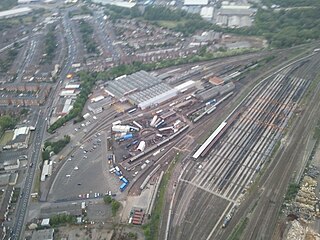
Tyseley TMD is a railway traction maintenance depot situated in Tyseley, Birmingham, England.
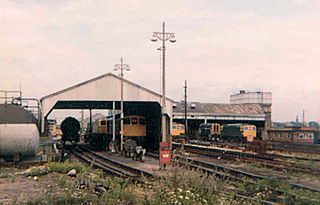
Hither Green (London) Traction Maintenance Depot or Hither Green (London) TMD is a railway depot used for the maintenance and servicing of freight trains adjacent to the Hither Green marshalling yard. The depot is a hub for moving freight around south-east England; it is owned and operated by DBS. The official depot code is HG; in steam days, the shed code was 73C.

Barnoldswick was the only railway station on the Midland Railway's 1-mile-64-chain (2.9 km) long Barnoldswick Branch in the West Riding of Yorkshire in England ; it served the market town of Barnoldswick. The line left the Leeds and Bradford Extension Railway at Barnoldswick Junction 55 chains from Earby. The line through the junction was on a 20-chain radius after which it converged to a single track and ran in a straight but undulating line to Barnoldswick. The passenger train that ran back and forth between Barnoldswick and Earby was known locally as the Barlick Spud or Spudroaster. The real reason for the name is lost in time, but the two versions that were commonly recited are that the original branch locomotive was so small it looked like a portable potato roaster used by a local vendor or that the journey time was the same as that taken to roast a potato in the locomotive's firebox.
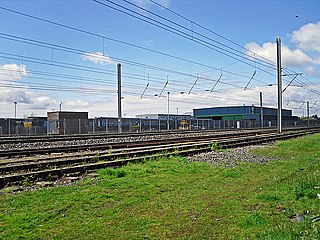
Carlisle Kingmoor TMD is a railway traction maintenance depot situated in Carlisle, England. The depot is operated by the Direct Rail Services (DRS). The depot was originally used to service diesel locomotives and diesel multiple units. The current depot code is KM. The original steam shed was called Carlisle (Kingmoor) and its shed code was originally 68A and later 12A.

March TMD is a railway traction maintenance depot situated near March, England. March was a steam locomotive shed under British Railways with the depot code 31B; the depot code of the diesel depot under BR was MR. The nearest railway station is March, and the depot was located close to the Whitemoor Marshalling Yard. Despite its rural location, in the 1970s it accommodated a similar number of locomotives to the comparatively larger Toton TMD and served as the main diesel depot for East Anglia.

Stratford TMD was a traction maintenance depot located in Stratford, London, England, close to the Great Eastern Main Line. It was located just west of Stratford station, on a site now occupied by Stratford International station. The depot was, at one time, the biggest on the London and North Eastern Railway with locomotives covering duties from express services to freight workings in London's docks.

St Leonards West Marina is a disused railway station in the Bopeep area of the borough of Hastings, East Sussex. Opened by the Brighton, Lewes and Hastings Railway in 1846, it was the first permanent station to serve the area and became part of a feud between two rival railway companies over access to nearby Hastings. Although not very convenient for local services, the station became an important goods rail-head and the location of a Motive Power Depot for steam locomotives working non electrified services, including those to London. The station was closed in 1967 and the buildings subsequently demolished, although in 2023 the down platform could still be seen.

Abergavenny railway station was a station on the London and North Western Railway's Heads of the Valleys line serving the town of Abergavenny in the Welsh county of Monmouthshire.
There were a number of engine sheds and railway works located in York. The large York North engine shed became the National Railway Museum in 1975.

Stewarts Lane is a large railway-servicing facility in Battersea in London, England, founded by the London, Chatham and Dover Railway (LCDR) in 1862, to serve London Victoria railway station. It is sited in the midst of a maze of railway lines between 'Factory Junction' and 'Stewarts Lane Junction', adjacent to the site of the former Longhedge Railway Works and the Stewarts Lane Chord formerly used by Eurostar trains from the Kent freight lines to Waterloo International station. Prior to 1962 it was one of the largest motive power depots in the UK. Following the end of steam traction in the early 1960s it was converted into a traction maintenance depot which is currently operated by Govia Thameslink Railway.
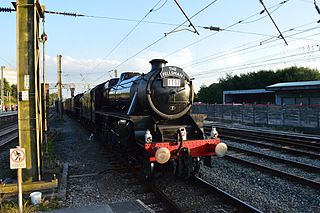
LMS Stanier Class 5MT 4932, is a preserved British steam locomotive. It is one of 18 surviving members of the Black 5 class which had 842 members constructed by five manufacturers. 44932 is the sole remaining member of the class which was built at the LMS's Horwich Works.
Norwich engine shed was located in Norwich, England and was opened in 1843. It closed in 1982 and was replaced by a new modern facility at Crown Point.

Holbeck TMD is a traction maintenance depot located in Holbeck, Leeds, England. The depot is located on the west side of the line from Woodlesford, and is 57 chains (1.1 km) south of Leeds railway station.
Manningham Engine Shed was a railway depot located in the Manningham suburb of Bradford in West Yorkshire, England. The depot was built to provide steam engines for services leaving Bradford Forster Square station and freight traffic from the Valley Road area of the city. It was also responsible for other sites at Keighley and Ilkley with Manningham itself being a sub-shed of Holbeck.

Bricklayers Arms was a railway station in Southwark opened by the London and Croydon Railway and the South Eastern Railway in 1844 as an alternative to the London and Greenwich Railway's terminus at London Bridge. The station was at the end of a short branch line from the main line to London Bridge and served as a passenger terminus for a few years before being converted to a goods station and engineering facility. The goods station closed in 1981.
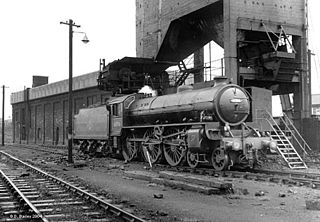
Low Moor engine shed was steam locomotive shed built adjacent to Low Moor railway station, south of Bradford in West Yorkshire, England. Originally opened in 1866 by the Lancashire and Yorkshire Railway, the depot was rebuilt in 1890, 1945 and lastly in 1948 when it was under British Railways ownership. It was closed to all traffic in 1967, being one of the last steam sheds in the Leeds and Bradford area.

















